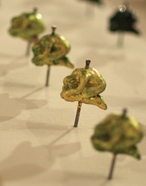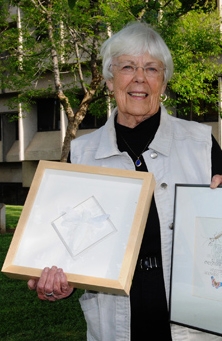- Author: Kathy Keatley Garvey

Organizers of the Consilience of Art and Science Show, a biannual display sponsored by the UC Davis Art/Science Fusion Program and the Pence Art Gallery, Davis, are reminding everyone that if you fuse art with science, remember this deadline: Dec. 15.
They're looking for drawings, paintings, watercolors, photographs, sculptures, textiles, video, and mixed media.
Entomologist-artist Diane Ullman, UC Davis professor of entomology and co-founder and co-director of the UC Davis Art/Science Fusion Program, says artists selected will show their work in the Pence Gallery from Jan. 26-March 2. The goals of the exhibition are three-fold: to show creative work that explores the intersection between art and science; to foster communication between the arts and sciences, and to spark new ways of viewing the world and ourselves, according to Ullman and Pence Gallery director Natalie Nelson.
The organizers encourage "creative work that transcends pure scientific illustration to explore the conceptional realm where art and science both reside." All artists and scientists, regardless of residence, can exhibit up to three works. This refers to original 2D and 3D work in any medium, related to the intersection between art and science. It encompasses photography, drawing, textiles, painting, sculpture, video and mixed media. Dimension restriction is at the discretion of the jurors.
Artists will upload their submissions online at http://www.pencegallery.org. A vital part of the submission is the artist's statement--not to exceed 100 words--which should clearly explain how the work relates to the art/science connection. The statement may be displayed with the accepted work. Work must be available for the entire run of the exhibit.
To enter, access http://www.pencegallery.org and click on "Call to Artists" to apply directly to the site. Entry fees are $35 and $40, respectively, for Pence and non-Pence members. Fees will be used for expenses and awards related to the exhibition. No hand-delivered art work will be accepted. Accepted work may be hand-delivered or shipped and insured by the artist to the Pence Gallery, 212 D St., Davis, CA 95616.
Jurors are Jiayi Young, a UC Davis assistant professor of design, and Helen Donis-Keller, Ph.D., the Michael E. Moody Professor of Biology and Art at Olin College of Engineering, Needham, Mass. The Consilience exhibit will be displayed in the Pence's Main Gallery's glass tower lit space, measuring 1000 square feet with 12-foot ceilings.
The Pence, established in 1975, is a non-profit art gallery. Its mission is to educate and inspire the community by exhibiting high caliber art by local and regional artists, according to director Natalie Nelson.
The calendar:
Dec. 15: Entry deadline online by 5 p.m.
Dec. 28: Notification via email
Jan. 19-20: Drop off between 11:30 a.m. and 4 p.m., or deadline for shipping arrival
Jan. 26-March 2: Exhibit dates
Feb. 9: Reception from 6 to 9 p.m.,with awards ceremony at 8
March 3-4: Pick up work, 12 to 4:30 p.m.
Sales are encouraged. The Pence Gallery will retain a 50 percent commission on work displayed at the exhibit. For more information on the exhibit, contact Nelson at (530)-758-3370 or penceartdirector@sbcglobal.net.

- Author: Kathy Keatley Garvey

Or engage in other science/art subjects?
You're invited to enter the Consilience of Art and Science Show, a biannual display sponsored by the UC Davis Art/Science Fusion Program and the Pence Art Gallery, Davis.
The entry deadline is 5 p.m., Dec. 15, announced entomologist-artist Diane Ullman, UC Davis professor of entomology and co-founder and co-director of the UC Davis Art/Science Fusion Program. Artists selected will show their work in the Pence Gallery from Jan. 26-March 2.
The goals of the exhibition are three-fold: to show creative work that explores the intersection between art and science; to foster communication between the arts and sciences, and to spark new ways of viewing the world and ourselves, according to Ullman and Pence Gallery director Natalie Nelson. The organizers encourage "creative work that transcends pure scientific illustration to explore the conceptional realm where art and science both reside."
All artists and scientists, regardless of residence, can exhibit up to three works. This refers to original 2D and 3D work in any medium, related to the intersection between art and science. It encompasses photography, drawing, textiles, painting, sculpture, video and mixed media. Dimension restriction is at the discretion of the jurors.
Artists will upload their submissions online at http://www.pencegallery.org. A vital part of the submission is the artist's statement--not to exceed 100 words--which should clearly explain how the work relates to the art/science connection. The statement may be displayed with the accepted work. Work must be available for the entire run of the exhibit.
To enter, access http://www.pencegallery.org and click on "Call to Artists" to apply directly to the site. Entry fees are $35 and $40, respectively, for Pence and non-Pence members. Fees will be used for expenses and awards related to the exhibition. No hand-delivered art work will be accepted. Accepted work may be hand-delivered or shipped and insured by the artist to the Pence Gallery, 212 D St., Davis, CA 95616.
Jurors are Jiayi Young, a UC Davis assistant professor of design, and Helen Donis-Keller, Ph.D., the Michael E. Moody Professor of Biology and Art at Olin College of Engineering, Needham, Mass. Both Young and Keller have exhibited nationally and internationally, fusing art with science.
Young holds a master's degree in fine arts (multimedia and painting) from Washington State University, Pullman, Wash.; a master of science in atomic physics from Kansas State University, Manhattan; and a bachelor's degree in fine arts and physics, Lawrence University, Appleton, Wisc. She works in the field of digital media with an emphasis on the cross-disciplinary areas of design, integrating art and science with cutting edge technology.
Keller who integrates the fields of art and biology, holds a master of fine arts in Studio Art from the Museum of Fine Arts in Boston and Tufts University, and a doctorate in biochemistry and molecular biology from Harvard University.
The Consilience exhibit will be displayed in the Pence's Main Gallery's glass tower lit space, measuring 1000 square feet with 12-foot ceilings. The Pence, established in 1975, is a non-profit art gallery. Its mission is to educate and inspire the community by exhibiting high caliber art by local and regional artists, according to director Natalie Nelson.
The calendar:
Dec. 15: Entry deadline online by 5 p.m.
Dec. 28: Notification via email
Jan. 19-20: Drop off between 11:30 a.m. and 4 p.m., or deadline for shipping arrival
Jan. 26-March 2: Exhibit dates
Feb. 9: Reception from 6 to 9 p.m.,with awards ceremony at 8
March 3-4: Pick up work, 12 to 4:30 p.m.
Sales are encouraged. The Pence Gallery will retain a 50 percent commission on work displayed at the exhibit.
For more information on the exhibit, contact Nelson at (530)-758-3370 or penceartdirector@sbcglobal.net


- Author: Kathy Keatley Garvey

The UC Davis Art/Science Fusion Program and the Pence Gallery, Davis, are co-sponsoring a “Consilience of Art and Science Exhibit,” set Jan. 14-Feb. 27, at the Pence Gallery, 212 D St., Davis.
This will include several special events: a reception on Jan. 14 from 6 to 9 p.m.; a talk by Byron Wolfe, photographer and professor of art at California State University, Chico, who will discuss the work of pioneer photographer Eadweard Muybridge; and a juror’s walk-through from 6 to 7 p.m., Feb. 11. All are free and open to the public. (See more information.)
Diane Ullman, co-founder and co-director of the UC Davis Art/Science Fusion Program, and James Housefield, professor of design at UC Davis, juried the show, which drew artists from California, including Davis and northern California; New Mexico, Oregon, Washington state, and New York.
“The artwork we received from artists across the nation explores the creative nexus where art and science interconnect," said Ullman, associate dean for undergraduate academic programs at the UC Davis College of Agricultural and Environmental Sciences, and professor of entomology. "The exhibit is visually and intellectually exciting and we commend the Pence Gallery for sponsoring it.”
Said Housefield: "Artists' investigations of the forms, structures, practices, and philosophies of science have provided long provided ways for the general public to dream about what art and science can become. We are very fortunate that the resources of the University of California, the arts communities of Davis, and a national array of contemporary artists come together in the space where art and science meet. I hope that this version of the 'Consilience' exhibition will spark more conversations about the ways that artists and scientists may inspire one another."
One of the works, by Joanna Kidd of Davis, is titled "Specimens." It is comprised of three wall cases and a floor case. Specimens are small human sculptures (see top photo), all pinned and displayed as they would be in an insect collection.
So very creative!
Housefield's comment about the ways that artists and scientists can inspire one another definitely holds true with "Specimens."



- Author: Kathy Keatley Garvey

It's a three-dimensional paper sculpture of a queen bee.
Noted artist Marilyn Judson (right) of Davis created the paper sculpture (below) now on display in the "Sticky Business: Art of the Honey Bee" show that runs through Dec. 23 at the Pence Gallery, 212 D St., Davis. Gallery hours are Tuesdays through Sunday from 11:30 a.m. to 5 p.m.
Judson has been around "bugs" all her life. Her husband, Charles Judson, is an emeritus professor of the UC Davis Department of Entomology.
Judson specializes in paper sculpture, calligraphy and watercolors. She has displayed her work throughout the area and worked in partnership with Davis artist Donna Billick in creating area murals.
She is one of 11 artists showing their work, which includes paintings, monoprints, sculpture and photographs.
The gist of the show is to incorporate "themes of environmental conservation with beautiful and thought-provoking fine art on the subject of the honey bee,” says curator Christopher Beer.
“The honey bee has provided sweetness to life that has benefited culture since the dawn of civilization. Now, scientists and farmers are eager to identify causes of the current decline of the honey bee population due to colony collapse disorder.”
Beer worked with regional artists and researchers from UC Davis “to investigate this unique insect’s relationship to the Valley and our way of life.”
And to point out the plight of the honey bee.

- Author: Kathy Keatley Garvey
A chimpanzee holds a monarch butterfly in a ceramic art work titled “
Human hands cradle insects and assorted objects in a ceramic work titled “Analyze This.”
Those are just two of the art works featured in a juried show under way at the Pence Gallery,
You can view the art, listen to music and talk to artists at the free public reception set for 7 to 9 p.m., Friday, March 13 at the gallery. The art is amazing, said Art/Science Fusion Program co-director Diane Ullman, associate dean undergraduate academic programs of the
The “Analzye This” piece is by Ann Savageau, associate professor of design at UC Davis. Savageau explains: “This is Art analyzing Science analyzing Nature. It makes visible the analytical methodology at the heart of the scientific endeavor. We take our measuring, probing, dissecting, and classifying for granted, as "the way things are". We forget that these are recent cultural constructs. “
Another ceramic work, “Twins,” by Marnia Johnston of
And it’s all a part of the Consilience of Art and Science Colloquium. What is consilience, you ask? William Whewell (1794-1866), who coined the term in 1840, described it as the linking together of facts and principles from different disciplines to form a broad, comprehensive theory that spans the realms of knowledge.
E. O. Wilson brought consilience into the modern lexicon with his highly acclaimed book, Consilience: The Unity of Knowledge.




